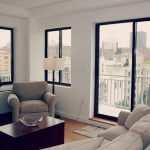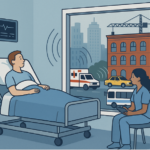NYC Local Law 97
New York City’s Climate Change Impact
It’s no secret that climate change is occurring at an alarming rate. Our Earth is warming, sea levels are rising, snow and ice worldwide are melting, and the overall wellbeing of our Earth is being greatly threatened. Now, more than ever, it is important to work together to prevent further climate change- and there are many ways that New York City can do its part.
Buildings contribute to nearly three-quarters of citywide emissions in NYC- which is why they are a great first place to start when tackling New York’s impact on climate change. Reducing emissions from these buildings will ultimately be the most impactful action the city could take to reduce NYC’s greenhouse gas emissions- and that is where the New York City Climate Mobilization Act and Local Law 97 comes into play. The good news? CitiQuiet has the perfect solution- CitiQuiet energy-efficient windows. Keep reading to see what this package of legislation means for you and how CitiQuiet can help you get in compliance with all of it!
New York City Climate Mobilization Act
In 2019, the New York City Council passed a package of laws that is being referred to as the “New York City Climate Mobilization Act.” This package of legislation is aimed at reducing greenhouse gas emissions and improving energy efficiency for certain New York City Buildings. Ultimately, it is the hope of the New York City Council to reduce New York’s overall negative contribution to the intensifying rate of climate change. By introducing the New York City Climate Mobilization Act, New York City will see a change in emitted emissions from over 50,000 buildings across Manhattan.
What is Local Law 97?
Many owners, developers, and companies are currently asking the question, “what is Local Law 97?” At the center of the New York City Climate Mobilization Act is NYC’s Local Law 97, or the Building Emissions Law, which is, by far, the primary and most impactful piece of the legislation. The purpose of Local Law 97 is to reduce carbon emissions from buildings which, as noted before, is ultimately the most effective means of reducing NYC’s carbon footprint. NYC’s Local Law 97 is the most ambitious law enacted by any city in the world in regards to confronting emissions issues from existing buildings. Essentially, it sets carbon emissions caps for energy use for a majority of NYC’s biggest buildings. In order to stay up to date with the New York City Climate Mobilization Act and Local Law 97, Citiquiet has partnered with the NYC Accelerator Service Provider Program to be a key service provider for those who need to get in compliance before the time benchmarks listed. It is Citiquiet’s hope that we can help solve all of your questions about “what is Local Law 97?” and help you better understand how it will impact your property in the future.
NYC Local Law 97 Details
As mentioned above, NYC Local Law 97 sets carbon emission caps for many large NYC buildings, specifically buildings larger than 25,000 square feet. This accounts for roughly 50,000 residential and commercial buildings across NYC. The caps start in 2024 and will continue to become more stringent over time. There are different carbon emissions intensity limits depending on the size and purpose of the building spaces. Overall, this law will apply to a number of properties across NYC but, in general, if a property is subject to NYC Benchmarking Law, then it is subject to Local Law 97 as well. There will be fines for those buildings that do not comply with the rules and regulations set by New York City’s Local Law 97, which are currently set at $268 per ton of emissions that are in excess of the individual building’s cap in any given year.
We understand that LL97 can be confusing to calculate, which is why we are sharing a Local Law 97 calculator created in partnership with NYC Accelerator and the Building Energy Exchange. The Local Law 97 calculator walks through how to calculate the carbon emissions coming from a building and the penalties associated with the amount of emissions produced after the varying benchmarks each year. By using this local law 97 calculator, you can easily project what your costs will be over the course of the next thirty years.
While many people have been asking “what is Local Law 97?”, there are also a large number of questions regarding who will be responsible for enforcing the laws within the New York City Climate Mobilization Act. These laws will be enforced by a brand new office inside the Building Department, which will be known as the Office of Building Energy and Emissions Performance (BEEP). This new office will enforce oversight, establish protocols, and review all building regulations and inspections to ensure that each building is compliant with Local Law 97 and the rest of the New York City Climate Mobilization Act.
Local Law 97 Goal
Ultimately, the goal of Local Law 97 is to reduce NYC building-based emissions by 40% by 2030. With the caps getting more stringent over time, the eventual goal is to reduce emissions by 80% by 2050. There are two compliance periods within this law- 2024-2029 and 2030-2034. The city will then clarify any additional requirements for future periods through 2050. The 2024 and 2030 emissions intensity limits were set to impact and combat the worst carbon emitters, so the average NYC building will meet the 2024 requirements. They will, however, most likely need to reduce emissions for the more stringent 2030 limits. By 2030, Local Law 97 is projected to reduce New York City’s carbon emissions by about 6 million tons, the equivalent of taking 1.3 million cars off of New York City’s roads! All of NYC’s property owners must begin looking into their emissions now so that they can get a head start on complying with Local Law 97 and lowering their individual emissions.
How To Reduce Carbon Emissions From a Building
There are a number of ways to reduce a building’s carbon emissions but, at the end of the day, saving energy is going to be the most effective way to do this. This means implementing energy-efficient best practices throughout the entire building, controlling the temperature, and taking the steps to reduce the overall energy building-wide. Luckily, one of the best ways to reduce energy use is to install new energy-efficient soundproof windows- a CitiQuiet specialty.
How CitiQuiet Can Help Your Building Comply With Local Law 97
As previously mentioned, the best way to reduce a building’s carbon emission is to save energy- and CitiQuiet offers a simple, attractive, and efficient solution to achieve this goal with energy-efficient, soundproof windows for NYC. Our energy-efficient soundproof windows reduce unwanted noises, are easy to install, and are energy efficient, allowing any building to save money on energy costs month after month. These windows offer thermal, moisture, and humidity control and offer a 99% reduction in dirt and drafts. Not to mention, they’re capable of blocking up to 95% of outside noise from entering your building. They’re energy efficiency in a sleek, market value improving package. CitiQuiet’s energy-efficient soundproof windows will make your building better, improve your tenant’s quality of life, and will help to ensure that you meet the requirements of NYC’s Local Law 97, a component of the New York City Climate Mobilization Act.
Benefits of Complying with NYC’s Local Law 97
Of course, when complying with New York City’s Local Law 97, there are the obvious benefits of avoiding fines and following the rules of New York legislation. However, there are many other additional benefits to compliance with the New York City Climate Mobilization Act that we want to highlight.
Saving Money
First, by implementing energy-saving practices and tools, such as CitiQuiet soundproof windows, you are lowering overall operating costs and improving your building’s bottom line. This means getting a bigger return on your investment, year after year.
Happier Tenants
By installing energy-efficient soundproof windows, you are also boosting tenant happiness and reducing overall tenant turnover. This is because tenants will likely be more comfortable, they will be saving money on their bills, and their overall quality of work and living will be greatly improved. No matter if it’s residential or commercial, CitiQuiet has you covered.
Property Value Boost
CitiQuiet’s soundproof windows are not only energy-efficient and effective in eliminating unwanted sound, but they will also increase the value of your property. In addition, they will also help with the marketability of these properties for future tenants and developers alike.
Improve New York
Last, but certainly not least, installing CitiQuiet’s soundproof windows will help to achieve the ultimate goal of reducing the carbon footprint, contributing to a healthier and cleaner New York, and staying in compliance with Local Law 97.
Why CitiQuiet?
CitiQuiet’s energy-efficient soundproof windows are a top-notch solution for New York City building owners and developers to get in compliance with the New York City Climate Mobilization Act and its subsidiary legislative act, Local Law 97. Our partnership with NYC Accelerator makes us one of the few companies that fully understand the ins and outs of this new legislation, making us a great choice for compliance. Your building will be better, your tenants will be happier, you will be better off, and the world will be a better place because of it- it really is a win-win all around!
For more information on the specific emissions limits, the results of failure to comply, how to measure your building’s carbon intensity, and more, visit https://www1.nyc.gov/ or The Urban Green Council’s website.



